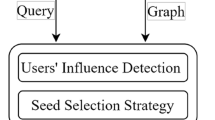Abstract
People that interact, cooperate or share common activities within information systems can be treated as a social network. The analysis of individual social standings appears to be a crucial element for the assessment of personal importance of each member within such weighted social network. The new measure of person significance – social position that depends on both the strength of relationships an individual maintains and social positions of all their acquaintances, together with its basic features and comparative experiments are presented in this paper.
Access this chapter
Tax calculation will be finalised at checkout
Purchases are for personal use only
Preview
Unable to display preview. Download preview PDF.
Similar content being viewed by others
References
Alexander, C.N.: A method for processing sociometric data. Sociometry 26, 268–269 (1963)
Bavelas, A.: Communication patterns in task – oriented groups. Journal of the Acoustical Society of America 22, 271–282 (1950)
Botafogo, R.A., Rivlin, E., Shneiderman, B.: Structural analysis of hypertexts: identifying hierarchies and useful metrics. ACM Trans. on Information Systems 10(2), 142–180 (1992)
Brin, S., Page, L.: The Anatomy of a Large-Scale Hypertextual Web Search Engine. WWW7, 1998, also Computer Networks and ISDN Systems 30(1-7), 107–117 (1998)
Everett, M., Borgatti, S.: Extending Centrality. In: Models and Methods in Social Network Analysis, Cambridge University Press, New York (2005)
Falzon, L.: Determining groups from the clique structure in large social networks. Social Networks 22, 159–172 (2000)
Freeman, L.C.: A set of measures of centrality based on betweenness. Sociometry 40, 35–41 (1977)
Freeman, L.C.: Centrality in social networks Conceptual clarification. Social Networks 1(3), 215–239 (1979)
Garton, L., Haythorntwaite, C., Wellman, B.: Studying Online Social Networks. Journal of Computer-Mediated Communication 3(1) (1997)
Hanneman, R., Riddle, M.: Introduction to social network methods. In: Online textbook, 01.04.2006 (2006), available at http://faculty.ucr.edu/~hanneman/nettext/
Kazienko, P.: Expansion of Telecommunication Social Networks. In: CDVE 2007. LNCS, vol. 4674, pp. 404–412. Springer, Heidelberg (2007)
Kazienko, P., Adamski, M.: AdROSA - Adaptive Personalization of Web Advertising. Information Sciences 177(11), 2269–2295 (2007)
Kazienko, P., Musiał, K.: Recommendation Framework for Online Social Networks. In: AWIC 2006. Studies in Computational Intelligence, vol. 23, pp. 111–120. Springer, Heidelberg (2006)
Kazienko, P., Musiał, K.: Social Capital in Online Social Networks. In: Gabrys, B., Howlett, R.J., Jain, L.C. (eds.) KES 2006. LNCS (LNAI), vol. 4252, pp. 417–424. Springer, Heidelberg (2006)
Sabidussi, G.: The centrality index of a graph. Psychmetrica, 31 (1966)
Shaw, M.E.: Group structure and the behavior of individuals in small groups. Journal of Psychology 38, 139–149 (1954)
Thurman, B.: In the office: Networks and coalitions. Social Networks 2, 47–63 (1979)
Wasserman, S., Faust, K.: Social network analysis: Methods and applications. Cambridge University Press, New York (1994)
Yang, W.S., Dia, J.B., Cheng, H.Ch., Lin, H.T.: Mining Social Networks for Targeted Advertising. In: HICSS-39 2006, IEEE Computer Society Press, Los Alamitos (2006)
Author information
Authors and Affiliations
Editor information
Rights and permissions
Copyright information
© 2007 Springer-Verlag Berlin Heidelberg
About this paper
Cite this paper
Kazienko, P., Musiał, K. (2007). Assessment of Personal Importance Based on Social Networks. In: Gelbukh, A., Kuri Morales, Á.F. (eds) MICAI 2007: Advances in Artificial Intelligence. MICAI 2007. Lecture Notes in Computer Science(), vol 4827. Springer, Berlin, Heidelberg. https://doi.org/10.1007/978-3-540-76631-5_50
Download citation
DOI: https://doi.org/10.1007/978-3-540-76631-5_50
Publisher Name: Springer, Berlin, Heidelberg
Print ISBN: 978-3-540-76630-8
Online ISBN: 978-3-540-76631-5
eBook Packages: Computer ScienceComputer Science (R0)




